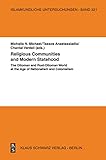Religious Communities and Modern Statehood : The Ottoman and post-Ottoman World at the Age of Nationalism and Colonialism / ed. by Chantal Verdeil, Michalis N. Michael, Tassos Anastassiadis.
Material type: TextSeries: Islamkundliche Untersuchungen ; 321Publisher: Berlin ; Boston : De Gruyter, [2020]Copyright date: ©2020Description: 1 online resource (320 p.)Content type:
TextSeries: Islamkundliche Untersuchungen ; 321Publisher: Berlin ; Boston : De Gruyter, [2020]Copyright date: ©2020Description: 1 online resource (320 p.)Content type: - 9783879974436
- 9783112209141
- online - DeGruyter
- Issued also in print.
| Item type | Current library | Call number | URL | Status | Notes | Barcode | |
|---|---|---|---|---|---|---|---|
 eBook
eBook
|
Biblioteca "Angelicum" Pont. Univ. S.Tommaso d'Aquino Nuvola online | online - DeGruyter (Browse shelf(Opens below)) | Online access | Not for loan (Accesso limitato) | Accesso per gli utenti autorizzati / Access for authorized users | (dgr)9783112209141 |
Frontmatter -- Table of Contents -- Introduction -- Imperial and Colonial Modernities -- Millet, Ethnicity, Colonial Community Views of the Authoritarian Transition to Modernity, 19th–early 20th c. -- Post-Colonial Criticism and Muslim-Christian Relations in the (very) Late Ottoman Empire: The Case of Smyrna/İzmir -- Ottoman Reforms and Colonial Policies -- From the Ottoman Meclis-i Idâre to the British Legislative Council -- Non-Muslim Communities and State Control in the Late Ottoman Empire -- Religious Communities, Secular Ideologies and Actors -- Cypriots Transforming their Identity during the Early British Period -- Modernity, Nationalism and Secularization: The Turkish Cypriot Case -- Christians and Jews in the French Strategy for Ottoman Palestine -- Missionary Presence, Diplomatic Rivalries and Proselytizing... among the Ottoman Empire’s Religious Communities -- Religious Community, Education and Statehood -- New Missions, New Education? -- The Organization and Development of Greek Orthodox Education in Cyprus,1830–1878 -- School, Community, State -- Comprehensive Bibliography -- List of Authors -- Index
restricted access online access with authorization star
http://purl.org/coar/access_right/c_16ec
Over the last thirty years, historiography has amply illustrated the ways in which modern statehood is linked to a specific form of governmentality characterized by increasing social penetration and control of peoples’ everyday daily lives. State tools included a variety of institutions, such as public education, mandatory military conscription, welfare and were served by complex bureaucratic organizations. As the Ottoman Empire was negotiating both its geopolitical survival and its own form of modern statehood, it tried to control the populations within its realm by instrumentalizing and simultaneously institutionalizing religious communities, thus producing an imperial state formation pattern that was both similar and distinct from other imperial or colonial projects. The existence of the religious communities and the functioning of the Ottoman state on their basis, made the passage from the Ottoman imperial structure to successor national and colonial states a complex process. This volume aims to explore various aspects of the communal organization in the Ottoman Empire for regions such as Asia Minor, Middle East and the Balkans, and to present the changes that occurred within the religious communities during the nineteenth century and particularly during the period running from the Tanzimat reforms to the First World War. Some of the key questions tackled in this volume are: How does the Sublime Porte understand the process of structuring a modern state with respect to religious communities? Who is responsible for modern institutions and why? Are religious actors being re-active or pro-active to the evolutions taking place on the state realm? Is the institutionalization of the religious communities best understood through a top-down institutional approach or thanks to a bottom-up analysis of the various agents’ strategies and interests? What is the legacy of the Ottoman debates and institutions once a territory has transformed into a national or colonial frame
Issued also in print.
Mode of access: Internet via World Wide Web.
In English.
Description based on online resource; title from PDF title page (publisher's Web site, viewed 28. Feb 2023)


